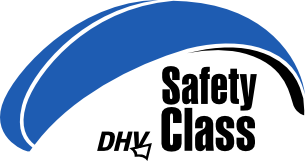Pica M |
|||||||||||||||||||||||||||||||||||||||||||||||||||||||||||||||||||||||||||||||||||||||||||||||||||||||||||||||||||||||||


|
|||||||||||||||||||||||||||||||||||||||||||||||||||||||||||||||||||||||||||||||||||||||||||||||||||||||||||||||||||||||||
Instability rating |
|||||||||||||||||||||||||||||||||||||||||||||||||||||||||||||||||||||||||||||||||||||||||||||||||||||||||||||||||||||||||
|
|||||||||||||||||||||||||||||||||||||||||||||||||||||||||||||||||||||||||||||||||||||||||||||||||||||||||||||||||||||||||
Glider characteristics |
|||||||||||||||||||||||||||||||||||||||||||||||||||||||||||||||||||||||||||||||||||||||||||||||||||||||||||||||||||||||||
|
Launch preparations: easy
launch characteristics: delayed, delayed climb, needs gentle guidance, no braking required, slows before zenith, tends to stall during control check
asymmetric collapse: canopy colllapses at high angle to leading edge, en: EinklapperDynamikGering, total course change 90-180°, (1), delayed course change, moderate forward pitching 45-60°, (2), moderate height loss 30-39 m, (2), low sink velocity 10-14 m/s, (1), G-Force < 2,5 G, (1)
Frontal collapse: canopy collapses with high total collapse aera, moderate pitch backwards 30-45°, low pitch forwards <30°, low dynamics, no course change, (1), variable recovery behaviour, at times immediate, at times delayed, automatic recovery, (3), usually symmetric recovery, horseshoe, wingtips at rear, delayed return to normal airspeed, delayed reinflation of wingtips, very high height loss >50 m, (4), low sink velocity 10-14 m/s, (1)
Spiral dives: moderate sink velocity increase, Moderate G-Force 3,5- 4.0 G, (2), Sink velocity after 720° <14 m/s, (1), Moderate maximum sink velocity < 18 m/s, (2), sink velocity increase < 6 m/s on brake release, (2), Course change 180-360° after spiral exit, (2), moderate height loss during recovery 30-60 m, (2)
B-Stall: normal force required, low pitch backwards <15°, low pitch forwards <15°, stable sink phase, no tendency to deform, immediate return to normal airspeed, 6-8 m/s, height loss on recovery 20-40 m
big ears: simple initiation, stable flight phase, immediate automatic recovery, Vsink unaccelerated 2,5-3 m/s, Vsink accelerated 3-3,5 m/s, Vunaccelerated 0-3 km/h less than trimspeed, Vaccelerated 3-5 km/h faster than trimspeed
Steering behaviour: balanced to agile, 85 cm brake travel range, no noticable brake pressure increase, en: StallOhneAnkuendigung |
|||||||||||||||||||||||||||||||||||||||||||||||||||||||||||||||||||||||||||||||||||||||||||||||||||||||||||||||||||||||||
Notes |
|||||||||||||||||||||||||||||||||||||||||||||||||||||||||||||||||||||||||||||||||||||||||||||||||||||||||||||||||||||||||
|
Take-Off The Take-Off preparations of the Pica are simple. The riser is clear structured and the lines are colorful separated. The line geometry is clearly structured. After the first impulse the glider needed some help by the pilot with the A-Risers to climb nicely. On the peak of climbing, the canopy slowed down by itself and remained clearly over the pilot. During the acceleration the glider stuck a bit behind the pilot (also during a linear acceleration) which causes a longer takeoff distance. Flight: The glider makes a damped impression and shows air movement significantly over the brakes and risers. The glider has a balanced to agile handling. The brakepressure was low. It was noticeable that the brakepressure was not increasing progressively. It was consistently low and just before the stall it increases. Caution is advisable particularly in the rapid initiation of a steep spiral. Asymmetric Collapse: The glider reacted calm and slow after asymmetric collapses in trimspeed. It was hard to pull big and surfacedeep coolapses. The glider pitches less than 45° to the front. The glider opens after 90° turning. All in all the glider turns 180°. Accelerated collapses were easier to pull surfacedeep and big. The reactions were calm as well. Pitching was around 50°-55°. The glider was turning between 180°to 360°. The glider opens after 90° The glider opens always calm. Cell by cell. Front Collapse: The dynamic was always low. The glider opens slowly and a bit delayed. During the opening the glider can switch back into paracutal but without critical reactions. The glider got the SafetyClass 4 because of its big loss of altitude during the maneuver and the opening. Spiral-Dive Due to its stall behavior the spiral should be entered with a lot sensibility. Fast spiralentries with no weightshift and just brake cause an asymmetric stall. The pilot has to keep an eye on the correct steering technique. The behavior of the glider during the spiral and exit is good. After releasing the brakes, the glider accelerates around 3m/s. The glider goes into straight flight after a complete 360° BigEars and B-Stall are easy. |
|||||||||||||||||||||||||||||||||||||||||||||||||||||||||||||||||||||||||||||||||||||||||||||||||||||||||||||||||||||||||
Rating |
|||||||||||||||||||||||||||||||||||||||||||||||||||||||||||||||||||||||||||||||||||||||||||||||||||||||||||||||||||||||||
|
Safety class 4 This class of paraglider reacts demandingly to one or more of the following manoeuvres: frontal collapse, asymmetric collapse or spiral dive.Demandingly means that the above manoeuvres result in marked dynamic reactions from the glider and/or large height losses. Advanced piloting skills which need to be regularly practised, together with good personal reaction times are required to safely fly this class of gliders. Basic recovery techniques for ending a manoeuvre are not sufficient to maintain control, reduce height loss to a minimum and prevent subsequent critical reactions. Pilots should be able to recognise the onset of the above manoeuvres and be able to prevent or minimise their effects through immediate and precise pilot inputs. Additional experience such as regular ground handling and SIV training is required to safely fly gliders of this class. Special training or pilot skills which exceed standard training may be required for the safe performance of emergency descent techniques. Gliders of this Safety Class are not suitable for beginners, irregular flyers or low-airtime pilots. |
|||||||||||||||||||||||||||||||||||||||||||||||||||||||||||||||||||||||||||||||||||||||||||||||||||||||||||||||||||||||||

